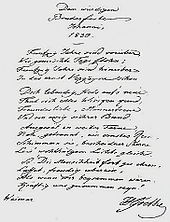Anna Amalia to the three roses

" Anna Amalia to the three roses " is the name of a Masonic lodge founded in 1764 in Weimar .
history
The lodge was founded on October 24, 1764, the birthday of its namesake Anna Amalia von Braunschweig-Wolfenbüttel , in Weimar as a Johannisloge . In the first decades there were violent disputes about direction, so that the lodge work officially ceased from 1782. This, in turn, rules out the fact that in the park on the Ilm the temple mansion and the Sphinx grotto at the Leutra spring , which could correspond to the motif according to Masonic symbolism, but that they owe their origin to Masonic intent.
After the death of Duchess Anna Amalia, Duke Carl August entrusted the Freemason brothers Johann Wolfgang Goethe and Friedrich Justin Bertuch with the resumption of the lodge work. Goethe commented on this on May 11, 1808: “When the appointment of a master of the chair at the Amalia Lodge to the Three Roses comes up, I give my vote to Legation Councilor Bertuch and note that this is done with the sentiments of our gracious Lord agrees ”. On October 24, 1808, Bertuch was elected Master of the Chair. In 1809 Christoph Martin Wieland was also accepted into the lodge. The seat of the lodge was the ballroom and the adjoining rooms in the Wittumspalais, which was vacated by the death of the Duchess .
In the 19th century, the lodge became one of the social centers in Weimar. From 1848 to 1853 the box room was located in a back building of the “Russischer Hof” hotel. In 1853 the company moved to the specially built box house on a piece of land from the estate of Johann Nepomuk Hummel on what was then Friedhofstrasse, today Amalienstraße 5.
With the ban on all Masonic lodges and the expropriation by the National Socialists in 1936, the lodge house was given other uses, badly damaged in World War II and later demolished.
After 1945, the work of the Weimar Masonic Lodge was initially allowed again by the Americans, but restricted again after the Soviet military administration took over and especially after the founding of the GDR . The few brothers who still had hope of a new beginning met as a private gentlemen's group in the Hotel Russischer Hof . The last admission to the lodge is said to have taken place privately in 1962.
In 1990 the lodge was re-established in Hamburg and the light was brought in in Weimar in 1992. The box first found a home in the Oberlichtsaal of the Bauhaus University and then for many years in the Hotel “Amalienhof”. From February 2006 to June 2009, the lodge used the vaulted cellar of the city museum (Bertuchhaus, Liebknechtstraße) and the lecture room there for public events. From 2009 to 2012 the lodge domicile was in the Kirms-Krackow-Haus on Jakobstrasse. In 2012 the box in the hotel “Leonardo” in Weimar found a new location. Special festive box works will continue to take place in the Weimar City Palace , Wittumspalais or in the Goethehaus .
Master from the chair
- 1764–1782: Jakob Friedrich von Fritsch
- 1808–1810: Friedrich Justin Bertuch
- 1810–1818: Cornelius Johann Rudolf Riedel (1759–1821), Provincial Directorate in Eisenach, Legation Councilor and Privy Councilor
- 1818–1851: Karl Wilhelm von Fritsch
- 1851–1866: Gottfried Theodor Stichling
- 1866–1869: Karl Friedrich Wilhelm Mohnhaupt, seminar and community school director
- 1869–1873: Heinrich Carl Gustav Herbst , Privy Finance Councilor
- 1873–1882: Karl Eduard Putsche
- 1882–1899: Julius Hugo Wernekke (1846–1929), director of the secondary school
- 1899–1921: Arthur Ott, professor at the secondary school
- 1921–1927: Adelbert Bachrodt, pharmacist
- 1927–1932: Georg Siefert, Senior Studies Director
- 1932–1934: Ernst Leißling, director of the Thuringian Institute for the Blind, special education teacher
- 1934–1935: Fritz Schirrmeister, manufacturer
- 1990–1994: Reinhard Reubold, in-house counsel and lawyer
- 1994–1996: Günter Dorn, tax advisor
- 1996–2004: Jochen Bretthauer, pastor and hotelier
- 2004–2008: Günther Ahrendt, administrative employee
- 2008–2012: Michael Hasenbeck, judge at the administrative court
- 2012–2016: Rolf Kalff, Clinic Director a. University professor
- 2016–2018: Gunther Smalian, entrepreneur
- since 2018: Alexander Weber
Other well-known members
- Christoph Martin Wieland (1733-1813)
- Johann Karl August Musäus (1735–1787)
- Friedrich Justin Bertuch (1747-1822)
- Ludwig Ernst Wilhelm von Schardt (1748–1826)
- Johann Wolfgang von Goethe (1749–1832)
- Justus Christian Loder (1753-1832)
- Carl Leonhard Reinhold (1757-1823)
- Carl August von Sachsen-Weimar-Eisenach (1757–1828)
- August Karl von und zu Egloffstein (1771–1834)
- Wilhelm Hoffmann (1777-1859)
- Johann Nepomuk Hummel (1778-1837)
- Friedrich Wilhelm Schwabe (1780–1842)
- Johann Georg Keil (1781–1857)
- Caspar von Geismar (1783–1848)
- Franz Carl Adelbert Eberwein (1786–1868)
- Karl von Schiller (1793-1857)
- Ludwig Preller (1809–1861)
- Christian Gottlob Tröbst (1811–1888)
- Hermann Böhlau (1826–1900)
- Louis Jungmann (1832-1892)
literature
- Karl Heinz Francke, Ernst-Günther Geppert: The Freemason lodges in Germany and their grand lodges 1737–1985; Register and register . Edition Quatuor Coronati, Bayreuth 1988, ISBN 3-925749-05-5 .
Sources and web links
Individual evidence
- ↑ Susanne Müller-Wolff: A landscape garden in the Ilmtal: The history of the ducal park in Weimar. Böhlau, Wien / Köln / Weimar 2007, ISBN 978-3-412-20057-2 , p. 166 and p. 152, note 39.
- ↑ a b Goethe and royal art. (No longer available online.) Kunstmuseum Hamburg, October 6, 2015, archived from the original on June 1, 2016 ; accessed on June 1, 2016 . Info: The archive link was inserted automatically and has not yet been checked. Please check the original and archive link according to the instructions and then remove this notice.



